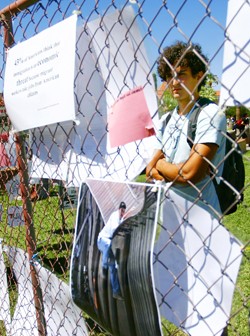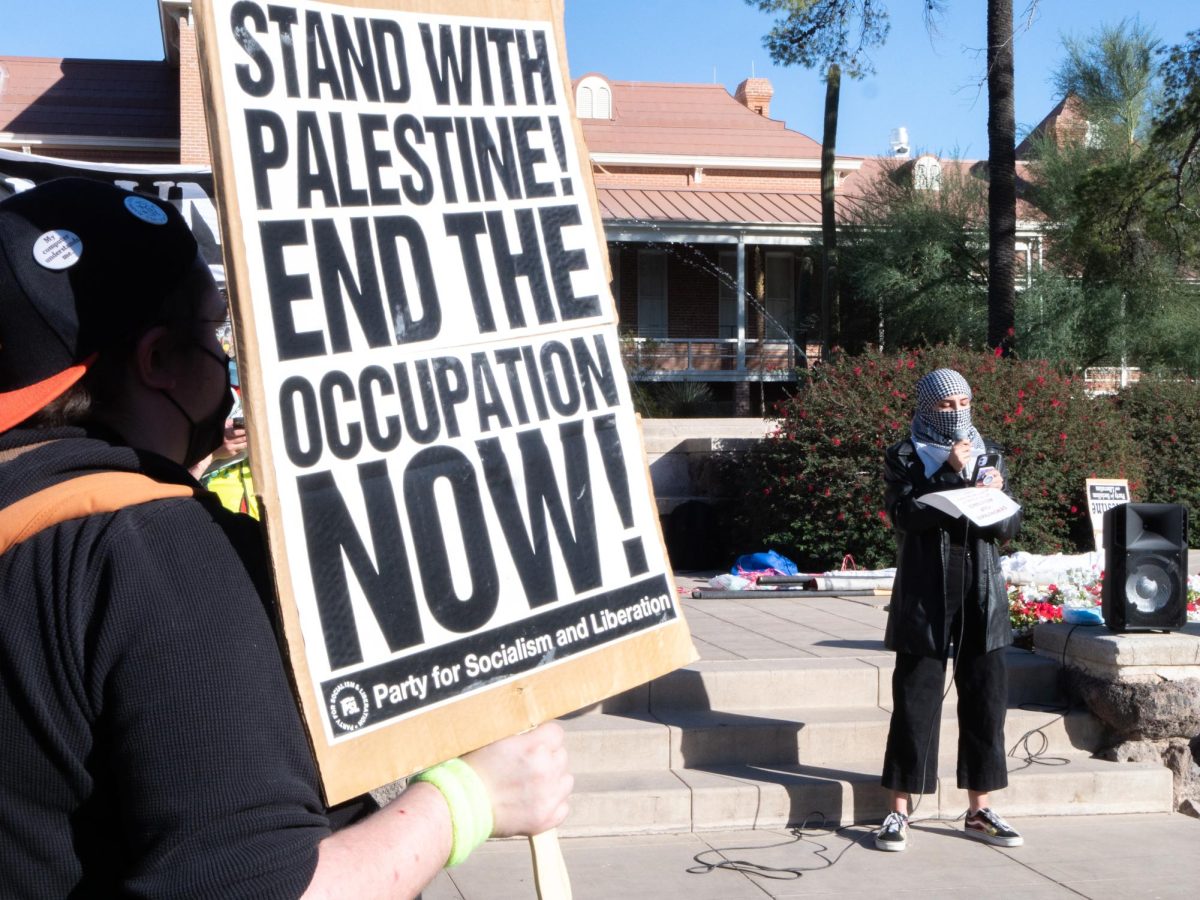The sounds of mariachi music played across the UA Mall as students were drawn to a chain link fence with tattered garments. One student walked the line of the fence, scanning each of the articles, while another stared at a laminated picture of a young girl holding a sign that read, “”We pay taxes too.””
“”It’s interesting,”” said Brian McMorran, a pre-physiology senior who stood contemplating a printed statistic. “”I think it’s an important issue, though.””
The fence, which spans the length of the east side of the Mall and has makeshift loops on top to mimic barbed wire, was created in collaboration with the Social Justice Leadership Center and Chicano/Hispano Student Affairs early yesterday as part of National Hispanic Heritage Month.
Attached to metal wires are what look like trash, soiled clothing and backpacks – all pieces of things left behind at the border from those who have attempted to come into the U.S.
The main focus this year for National Hispanic Heritage Month – which will have on-campus events through Oct. 23 – is immigration, said Jennifer Hoefle, senior coordinator for the leadership center.
In the upcoming month, people are encouraged to attend panel discussions, films and art displays to educate themselves about Hispanic culture. But as some cannot always attend, Hoefle said, the university needed an educational effort that would be accessible to all.
“”We wanted to have a passive education piece for the month, because it’s important for us to get out information to as many people as possible,”” Hoefle said.
She said many volunteers contributed to the construction of the fence, laminating and cutting an array of articles and information in the attempt to present all different sides of an often sensitive issue.
A public health graduate student and assistant for Social Justice Programs, Jessica Risco said the fence is not only a display for people to learn from, but a living creation that everyone can be part of.
“”We tried to hit (immigration) from all sides of the issue because it is a controversial issue, but we also want people to know that it’s a living and breathing thing, and it can be added to if they feel that some perspective is missing, or really anything – they’re welcome to do that,”” Risco said.
Oscar Angulo, an administrative assistant at the Chicano/Hispano Student Affairs, said that much of Hispanic Heritage Month is about discussion, and part of that is about recognizing where people come from.
“”Lately, there has been attention and a focus put on immigration,”” Angulo said. “”But there’s a lot of people (who) live here that grew up here that are from other countries, and we try to connect the old with the new and teach people who want to know about their roots.””
On the border are bright pink index cards attached every few feet to the fence. On these cards, people write their own thoughts about the events they’ve seen.
McMorran said while looking at the mock border, he was reminded of the importance of the issue of illegal immigration.
“”Since we have the election coming up and everything like that, the economy is really taking the forefront of some of the issues, but this is still an issue that each of the candidates has their position on, and it’s something that needs to be brought up for consideration,”” McMorran said.
Others said the display might cause mixed emotions for some who see it.
“”I personally don’t get offended by this at all, but I feel like there would be some Hispanic people out there (who) would,”” said Albert Molina, an engineering sophomore. “”Like, I was born here, but I was raised in Mexico, and I lived there for like five years, then moved back. But for people who have lived all their life in a Hispanic country and then come back and watch this – I could understand if they find it offensive.
“”They might have family members or relatives that have crossed it, and a lot of people die while doing that.””
There may be U.S.-born students that would take offense as well, “”because there are a lot of people (who) don’t want Hispanics in this country,”” Molina said.
McMorran said the structure of the display as a border that blocks part of the Mall made its purpose more intense.
“”It forces people to pay respect to the issue. I think for a lot of people in our lives, we live in our own secluded world,”” McMorran said. “”We’re not even that far from the border, but it’s still so non-present in our everyday lives. I think it forces people to remember that it’s still an issue, and I think they did a really good job at trying to show both sides of the issue.””
Although the idea to build the fence was somewhat controversial, the motivation for the participants to construct it was to “”challenge themselves,”” Hoefle said, and create something that would “”start a large dialogue on campus”” about immigration.
“”I think when you (set up programs), either people’s schedules are busy or there’s just too much going on, but this is like in the middle of campus,”” Hoefle said. “”It will force you to stop and look at it, and even if you read one thing about it, that’s kind of the goal.””









